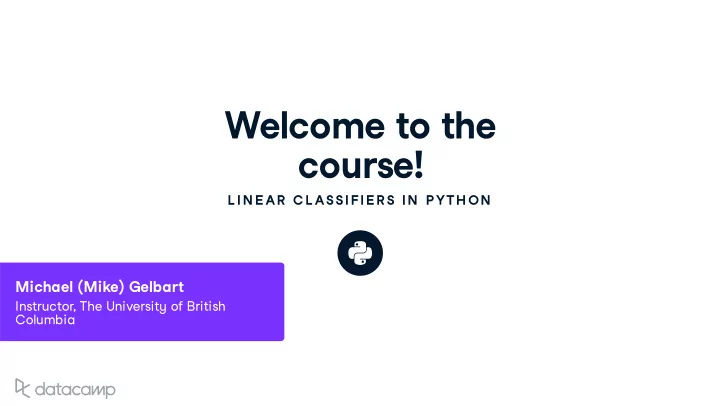

Welcome to the co u rse ! L IN E AR C L ASSIFIE R S IN P YTH ON Michael ( Mike ) Gelbart Instr u ctor , The Uni v ersit y of British Col u mbia
Ass u med kno w ledge In this co u rse w e ' ll ass u me y o u ha v e some prior e x pos u re to : P y thon , at the le v el of Intermediate P y thon for Data Science scikit - learn , at the le v el of S u per v ised Learning w ith scikit - learn s u per v ised learning , at the le v el of S u per v ised Learning w ith scikit - learn LINEAR CLASSIFIERS IN PYTHON
Fitting and predicting import sklearn.datasets newsgroups = sklearn.datasets.fetch_20newsgroups_vectorized() X, y = newsgroups.data, newsgroups.target X.shape (11314, 130107) y.shape (11314,) LINEAR CLASSIFIERS IN PYTHON
Fitting and predicting ( cont .) from sklearn.neighbors import KNeighborsClassifier knn = KNeighborsClassifier(n_neighbors=1) knn.fit(X,y) y_pred = knn.predict(X) LINEAR CLASSIFIERS IN PYTHON
Model e v al u ation knn.score(X,y) 0.99991 from sklearn.model_selection import train_test_split X_train, X_test, y_train, y_test = train_test_split(X, y) knn.fit(X_train, y_train) knn.score(X_test, y_test) 0.66242 LINEAR CLASSIFIERS IN PYTHON
Let ' s practice ! L IN E AR C L ASSIFIE R S IN P YTH ON
Appl y ing logistic regression and SVM L IN E AR C L ASSIFIE R S IN P YTH ON Michael ( Mike ) Gelbart Instr u ctor , The Uni v ersit y of British Col u mbia
Using LogisticRegression from sklearn.linear_model import LogisticRegression lr = LogisticRegression() lr.fit(X_train, y_train) lr.predict(X_test) lr.score(X_test, y_test) LINEAR CLASSIFIERS IN PYTHON
LogisticRegression e x ample import sklearn.datasets wine = sklearn.datasets.load_wine() from sklearn.linear_model import LogisticRegression lr = LogisticRegression() lr.fit(wine.data, wine.target) lr.score(wine.data, wine.target) 0.972 lr.predict_proba(wine.data[:1]) array([[ 9.951e-01, 4.357e-03, 5.339e-04]]) LINEAR CLASSIFIERS IN PYTHON
Using LinearSVC LinearSVC w orks the same w a y: import sklearn.datasets wine = sklearn.datasets.load_wine() from sklearn.svm import LinearSVC svm = LinearSVC() svm.fit(wine.data, wine.target) svm.score(wine.data, wine.target) 0.893 LINEAR CLASSIFIERS IN PYTHON
Using SVC import sklearn.datasets wine = sklearn.datasets.load_wine() from sklearn.svm import SVC svm = SVC() # default hyperparameters svm.fit(wine.data, wine.target); svm.score(wine.data, wine.target) 1. Model comple x it y re v ie w: Under � � ing : model is too simple , lo w training acc u rac y O v er � � ing : model is too comple x, lo w test acc u rac y LINEAR CLASSIFIERS IN PYTHON
Let ' s practice ! L IN E AR C L ASSIFIE R S IN P YTH ON
Linear decision bo u ndaries L IN E AR C L ASSIFIE R S IN P YTH ON Michael ( Mike ) Gelbart Instr u ctor , The Uni v ersit y of British Col u mbia
Linear decision bo u ndaries LINEAR CLASSIFIERS IN PYTHON
Definitions Vocab u lar y: classi � cation : learning to predict categories decision bo u ndar y : the s u rface separating di � erent predicted classes linear classi � er : a classi � er that learns linear decision bo u ndaries e . g ., logistic regression , linear SVM linearl y separable : a data set can be perfectl y e x plained b y a linear classi � er LINEAR CLASSIFIERS IN PYTHON
Linearl y separable data LINEAR CLASSIFIERS IN PYTHON
Let ' s practice ! L IN E AR C L ASSIFIE R S IN P YTH ON
Recommend
More recommend